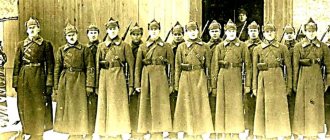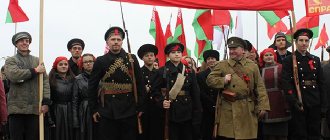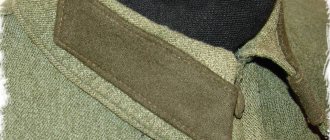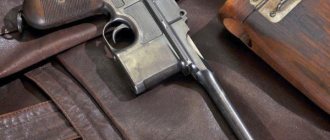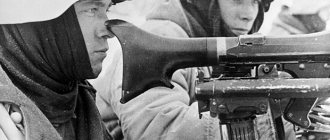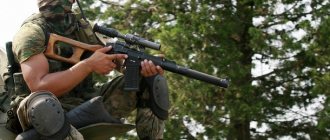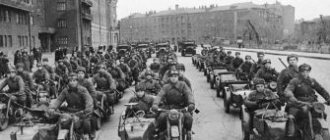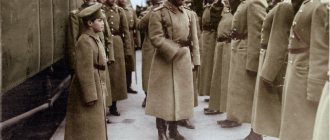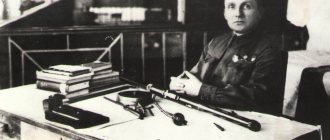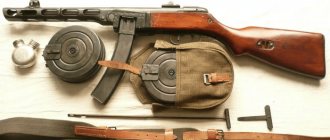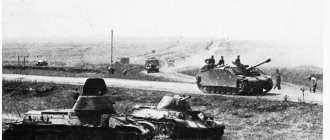Vasily Chapaev
The name of Vasily Ivanovich Chapaev was surrounded by legends during his lifetime. He was not the commander-in-chief and did not carry out large-scale military operations, but in the minds of ordinary people he remained a favorite commander among the people.
Chapaev had no education other than the parochial school and the Military Academy in Moscow, where he spent only three months. In this sense, the jokes about Vasily Ivanovich correspond to reality. Stalin’s idea of Chapaev’s simplicity is another matter. In fact, the “red ataman” was a very smart and resourceful person, he knew the history of Russia very well, and fought competently.
Portrait of Vasily Ivanovich Chapaev, 2022 A. Mironov. Source: artmiro.ru
On the battlefield, the impetuous, reckless, self-taught commander preferred partisan methods, followed discipline, and was the first to rush into the thick of battle, setting an example for others. This is exactly how the Vasiliev brothers portrayed him in their film.
After the revolution, the head of the 25th Infantry Division of the Red Army, Chapaev, fought against Kolchak. Having perfectly studied the area, in 1919 he crossed the Belaya River and occupied Ufa and Uralsk. There, in an unequal battle with the White Guards, the life of the brave division commander was cut short.
The death of Chapaev also became a legend. Some believe that he died from wounds during the shootout. Others insist that Vasily Ivanovich drowned while swimming across the Ural River. Still others are completely sure that the commander was saved. In the popular consciousness, Chapaev is truly the most alive of all the living. Countless stories and anecdotes confirm this.
5th Army
Commanders
1st formation:
- Ensign Sivers Rudolf Ferdinandovich
2nd formation:
- Voroshilov Kliment Efremovich
3rd formation:
- Colonel Slaven Petr Antonovich (August 16 - October 20, 1918)
- Captain Blumberg Jean Karlovich (October 20, 1918 - April 5, 1919)
- Second Lieutenant Mikhail Nikolaevich Tukhachevsky (April 5 - November 25, 1919)
- Staff Captain Eikhe Heinrich Khristoforovich (November 25, 1919 - January 21, 1920)
- Yesaul Kutyrev Gavriil Yakovlevich
(temporarily acting, January 24 - February 3, 1920) - Colonel Garf Wilhelm Evgenievich
(temporarily acting, February 3 - 8, 1920) - Colonel Matiyasevich Mikhail Stepanovich (February 8, 1920 - August 27, 1921)
- Second Lieutenant Uborevich Ieronim Petrovich (August 27, 1921 - August 14, 1922)
- Lieutenant Colonel Lyubimov Vladimir Vissarionovich
(temporarily acting, August 14 - 24, 1922) - Tchaikovsky Kasyan Alexandrovich (August 24 - September 6, 1922)
Chiefs of Staff
- Colonel Anders Alexander-Valerian Karlovich
(temporary position, August 16 - November 22, 1918) - Captain Polikarpov Mikhail Alekseevich
(temporarily acting, October 2 - November 22, 1918) - Lieutenant Colonel Ermolin Pavel Ivanovich
(November 22, 1918 - July 27, 1919) - captain Ivasiov Yakov Klementievich
(July 27 - December 3, 1919) - Yesaul Kutyrev Gavriil Yakovlevich
(temporarily acting, December 3, 1919 - February 8, 1920) - Colonel Garf Wilhelm Evgenievich
(February 8 - June 23, 1920) - Smorodinov Ivan Vasilievich (temporary position, June 23 - September 4, 1920)
- Lieutenant Colonel Lyubimov Vladimir Vissarionovich
(September 4, 1920 - September 6, 1922)
Semyon Budyonny
Semyon Budyonny was born in the Donskaya village of Platovskaya in 1883. At the age of nine, he was assigned as a hammerman to the forge of a rich merchant. From morning to night he forged horseshoes, and then went to clean up the clerk's house. This is how he paid for his education: the clerk undertook to teach him literacy and writing. At the age of 20, the sledgehammer, broom and book were replaced by a rifle.
“Being in the army since January 1, 1904, he had the Russo-Japanese War behind him. During the First World War he participated on the Western Front, on the Turkish Front, in Mesopotamia and in the Baghdad region,” Budyonny’s diary entries read.
Semyon Budyonny with children. (wikipedia.org)
Budyonny joined the Red Army at the very beginning, creating a cavalry detachment in February 1918 to fight the White Guards on the Don. He participated in the defeat of Wrangel's Caucasian army, the Cossack corps of Mamantov and Shkuro, and Denikin's troops in the Crimea.
During the Great Patriotic War, Semyon Mikhailovich was first the commander of the reserve army group at Headquarters, then, before the disaster near Kiev, he served as commander-in-chief of the troops of the South-Western direction. This was followed by leadership of the Reserve and North Caucasus Fronts. The Battle of the Caucasus, which can hardly be attributed to the successes of the Red Army, again made adjustments to Budyonny’s military career. In 1943, he headed the cavalry of the Red Army and remained in this position until 1953.
The legendary rider, creator of the First Cavalry Army, winner of many awards, one of the first Soviet marshals, passed away in October 1973. They say that Budyonny’s favorite horse, Sophist, immortalized by the sculptor Tomsky, cried like a man when his owner went to the best of worlds.
3rd Army
1st formation
Commanders
- Lazarev P.S. (moved to white)
- Chikvanaya E.I.
- Lieutenant Colonel Bogoslovsky Boris Petrovich
(07/23/1918 went over to the whites when leaving Yekaterinburg)
Chiefs of Staff
- Staff Captain Andrei Leonidovich Simonov
(06/14/1918-07/19/1918) (07/1918 went over to the Whites when leaving Yekaterinburg)
2nd formation
Commanders
- Lieutenant Berzin Reingold Iosifovich (06/14/1918-11/29/1918)
- non-commissioned officer Mikhail Mikhailovich Lashevich (11/30/1918-03/05/1919)
- captain Mezheninov Sergei Alexandrovich
(03/05/1919-08/26/1919) - Staff Captain Alafuso Mikhail Ivanovich
Vrid (08/26/1919-10/06/1919) - Colonel Matiyasevich Mikhail Stepanovich (07.10.1919-15.01.1920)
Chiefs of Staff
- Lieutenant Colonel (03.1916) Orel Vladimir Fedorovich (07.28.1918-08.04.1918)
- non-commissioned officer Mikhail Mikhailovich Lashevich (08/05/1918-08/07/1918)
- Staff Captain Aplok Yuri Yuryevich (08/07/1918-08/31/1918)
- Staff Captain Alafuso Mikhail Ivanovich
(08/31/1918-08/26/1919) - Staff Captain Gerasimov Ivan Ivanovich
Vrid (08/26/1919-10/06/1919) - Staff Captain Alafuso Mikhail Ivanovich
(07.10.1919-09.11.1919) - Staff Captain Gerasimov Ivan Ivanovich
Vrid (11/10/1919-11/26/1919) - Lieutenant Colonel Lyubimov Vladimir Vissarionovich
Vrid (11/27/1919-12/19/1919) - Lieutenant Colonel Sergeev Evgeniy Nikolaevich
(12/19/1919-01/15/1920)
3rd formation
Commanders
- Lieutenant Colonel Lazarevich Vladimir Solomonovich
(06/12/1920-10/18/1920) - Colonel Beloy Alexander Sergeevich
Vrid (10/18/1920-10/24/1920) - Colonel Kakurin Nikolai Evgenievich
(10/24/1920-12/31/1920)
Chiefs of Staff
- Roshkovsky Alexander Illarionovich Vrid (06/12/1920-07/04/1920)
- Lieutenant Colonel Nikolai Vasilievich Lisovsky
(07/04/1920-10/20/1920) - Lieutenant Colonel Taranovsky Alexander Dmitrievich
Vrid (20.10.1920-02.12.1920) - Lieutenant Colonel Nevezhin Konstantin Petrovich
(02.11.1920-31.12.1920)
Mikhail Frunze
Mikhail Vasilyevich Frunze was born in the city of Pishpek in the family of a paramedic and a peasant woman. He was the second of five children. His father died when Misha was 12 years old. The family was in great need, so the state paid for the education of the two older brothers. Subjects were easy for the future commander, especially languages, and the director of the gymnasium predicted a great future for the gifted young man. Mikhail graduated from the educational institution in 1904 with a gold medal, without exams he was enrolled in the economics department of the St. Petersburg Polytechnic Institute.
Frunze later said about his rapid military career that he received his primary military education by shooting at the officers in Shuya, his secondary education against Kolchak, and his higher education on the Southern Front, defeating Wrangel. Being a brave man, Mikhail Vasilyevich always walked in the vanguard. In 1919, near Ufa, it almost cost him his life.
Mikhail Frunze. (wikipedia.org)
Frunze was not afraid to “fight” with the rebel peasants, punishing them for “class ignorance.” He was a talented organizer and skillfully selected competent specialists. True, the chairman of the Revolutionary Military Council, Trotsky, did not show much enthusiasm about this, believing that the army commander “was captivated by abstract schemes, he had a poor understanding of people and easily fell under the influence of specialists, mostly secondary ones.”
According to the official version, Mikhail Vasilyevich Frunze died after stomach surgery on October 31, 1925.
6th Army
1st formation
Commanders
- Colonel Gittis Vladimir Mikhailovich (September 11, 1918 - November 22, 1918)
- Major General Samoilo Alexander Alexandrovich
(November 22, 1918 - May 2, 1919) - Colonel Glagolev Vasily Pavlovich
(May 2, 1919 - May 29, 1919) - Major General Samoilo Alexander Alexandrovich
(May 29, 1919 - April 15, 1920)
Chiefs of Staff
- Major General Samoilo Alexander Alexandrovich
(September 11, 1918 - November 22, 1918) - Colonel Petin Nikolai Nikolaevich
(November 29, 1918 - May 23, 1919) - Colonel Yatsko Ivan Vasilievich
(May 23, 1919 - October 27, 1919) - Lieutenant Colonel Nikolai Vasilievich Lisovsky
(October 27, 1919 - November 22, 1919) - Colonel Yatsko Ivan Vasilievich
(November 22, 1919 - January 2, 1920) - Lieutenant Colonel Lisovsky Nikolai Vasilievich
(January 2, 1920 - April 15, 1920)
2nd formation
Commanders
- Second Lieutenant Avksentievsky Konstantin Alekseevich (August 20, 1920 - October 26, 1920)
- Lieutenant Colonel Kork August Ivanovich
(October 26, 1920 - May 13, 1921)
Chiefs of Staff
- Colonel Tokarevsky Vyacheslav Konstantinovich
(August 19, 1920 - December 3, 1920) - Captain Kirpichnikov Alexey Vladimirovich
(December 3, 1920 - May 13, 1921)
Members of the RVS
- Ensign Oshley Petr Matveevich (03.12.1920-18.01.1921)
Grigory Kotovsky
The son of tradesman Ivan Nikolaevich Kotovsky, Grigory, became a revolutionary from a criminal background. He killed the intractable father of his beloved and burned the estate. Hiding in the forests from justice, the future divisional commander formed a gang from convicts and prisoners, whose crimes and robberies were distinguished by their particular insolence and cynicism. Physically strong and dexterous by nature, Grigory managed to evade responsibility each time, but in 1907, luck turned against him. Sentenced to 12 years of hard labor, he was sent to Siberia in a stage. Counting on an amnesty, but never receiving it, Kotovsky fled again six years later. In 1915, in his native Bessarabia, he led a new gang.
Grigory Kotovsky. (cyrillitsa.ru)
Raids on offices and banks led the legendary commander to the gallows. But then the revolution broke out. Conditionally released and sent to the front, already in the fall of 1917 Kotovsky was awarded the St. George Cross for bravery in battle. This was followed by work to establish Soviet power in Odessa, the fight against the Petliurites, Makhnovists and Antonovites, and active cooperation with Mishka Yaponchik.
The latter’s name, by the way, appears in one of the versions of the reasons for the murder of Kotovsky. Allegedly, his former adjutant took revenge on the Red commander for the execution of the “criminal authority” of Odessa.
7th Army
Commanders
- Major General Iskritsky Evgeniy Andreevich
(01.11.1918-28.11.1918) - Colonel Golubintsev Evgeniy Matveevich Vrid (11/28/1918-12/05/1918)
- Major General Henrikson Nikolai Vladimirovich
Vrid (05.12.1918-27.01.1919) - Major General Remezov Alexander Kondratyevich
(01/27/1919-07/01/1919) - Colonel Matiyasevich Mikhail Stepanovich (07/01/1919-09/26/1919)
- Colonel Kharlamov Sergei Dmitrievich
(09/26/1919-10/17/1919) - Lieutenant General Nadezhny Dmitry Nikolaevich
Vrid (10/17/1919-11/17/1919) - Major General Odintsov Sergei Ivanovich
(11/17/1919-07/30/1920) - non-commissioned officer Lashevich Mikhail Mikhailovich Vrid (07/30/1919-08/25/1920)
- Colonel Zarubaev Vladimir Nikolaevich
(08/25/1920-03/05/1921) - Second Lieutenant Mikhail Nikolaevich Tukhachevsky (03/05/1921-03/19/1921)
- Staff Captain Avrov Dmitry Nikolaevich (03/19/1921-05/10/1921)
Chiefs of Staff
- Lieutenant Colonel Mediokritsky Vasily Evgenievich
(01.11.1918-08.11.1918) - Colonel Shishkin Vladimir Ivanovich
(01/08/1918-12/25/1918) - Major General Tsygalsky Mikhail Viktorovich
(12/25/1918-05/08/1919) - captain Golubev Sergei Nikolaevich
(05/08/1919-07/05/1919) - captain Lyutov Alexander Dmitrievich
Vrid (30.09.1919-17.10.1919) - Major General Alexandrov Leonid Kapitonovich
(10/17/1919-11/14/1919) - Colonel Kharlamov Sergei Dmitrievich
(11/14/1919-12/31/1919) - captain Enden Mikhail Mikhailovich
Vrid (12/31/1919-01/27/1920) - Colonel Zarubaev Vladimir Nikolaevich
(01/27/1920-09/25/1920) - Major General Plyushchevsky-Plyushchik Grigory Aleksandrovich
Vrid (25.09.1920-07.10.1920) - Lieutenant Colonel Rostov Lev Nikolaevich
(07.10.1920-03.03.1921) - Captain Peremytov Alexey Makarovich
Vrid (03.03.1921-10.05.1921)
Nikolay Shchors
Nikolai Shchors was from small Snovsk. After graduating from parochial school, he decided to go to seminary, although he never dreamed of a career as a priest. The First World War changed everything.
Having left behind him training at the Kyiv military paramedic school and participation in hostilities on the North-Western Front, Nikolai moved to the classrooms of the Vilna Military School, which trained junior warrant officers for the army in an accelerated course. This was followed by service on the Southwestern and Romanian fronts, the rank of second lieutenant, and infection with tuberculosis.
Shchors. USSR postcard from the series “Heroes of the Civil War”, 1961. L. Golovanov, D. Domogatsky, L. Kotlyarov. (wikipedia.org)
In Simferopol, where Shchors was undergoing treatment, he fell under the influence of the Bolsheviks, joined the revolutionary movement and, returning to his homeland, went under the scarlet banners. When German troops occupied the Chernihiv region, the ex-second lieutenant fully demonstrated his talent as a commander: he organized a rebel partisan detachment and “disturbed” the Germans for two months, and then retreated to the territory of Soviet Russia.
Since 1918, Shchors’s military career rapidly gained momentum: first he was the commander of the “Ukrainian Revolutionary Regiment named after Comrade Bohun”, then the commander of the 2nd Brigade of the 1st Ukrainian Soviet Division, after the occupation of Kiev - a military commandant, then - the head of the 44th Infantry divisions of the Red Army. Perhaps the “Ukrainian Chapaev,” as Stalin called Nikolai Shchors, would have reached even greater heights if the bullet had not cut short his life. Who fired this bullet is still a mystery.
One way way
This is not surprising - treason in the conditions of the Civil War requires determination and courage due to the unpredictability of the consequences. High-ranking traitors in most cases belonged to approximately the same age group (in 1919) from 33 to 40 years. N.A. was significantly older than the others. Zhdanov, who turned 52 in 1919, was slightly younger than P.A. Slaven (45 years old).
The 2nd Army of the Soviet Eastern Front was more unlucky than others, two of whose army commanders (F.E. Makhin and A.I. Kharchenko) committed treason directly in these positions, and the third, V.V. Yakovlev, later. Five cases of treason are associated with the Eastern Front, two with the Southern Front and one with the Western Front. Only three cases of betrayal are related to the events of 1919, five cases date back to 1918, when the situation was more chaotic.
Vsevolodov and Zhdanov fled to the enemy with their families. Bogoslovsky also ended up with the whites and his wife (according to one version, they fled together, according to another, the defector’s wife ended up with the whites, remaining in Yekaterinburg). The details of such a plan are unknown about the remaining traitors.
In Soviet Russia, some defectors (Vsevolodov, Zhdanov) were considered executed, although this was not true (perhaps it was beneficial for relatives to voice such a version in order to avoid persecution and for propaganda purposes to the command). However, the fates of most of the high-ranking traitors did not turn out very well. Three of them (Bogoslovsky, Muravyov, Kharchenko) died violent deaths in connection with their actions in the Civil War, Slaven died in custody for the same reason. Yakovlev was shot in the 1930s. Only three (Vsevolodov, Zhdanov and Makhin) died many years later in exile.
Ultimately, it was not treason, even at the very top, that set the vector of development of the Red Army, since the majority of military specialists at all levels served conscientiously.
10th Army
Commanders
- Voroshilov Kliment Efremovich (October 3 - December 18, 1918)
- Staff Captain Nikolai Akimovich Khudyakov (December 18 - 26, 1918)
- Lieutenant Colonel Egorov Alexander Ilyich (December 26, 1918 - May 25, 1919)
- Lieutenant Colonel Klyuev Leonid Lavrovich
(May 26 - December 28, 1919) - Lieutenant Pavlov Alexander Vasilievich (December 28, 1919 - June 20, 1920)
- Colonel Glagolev Vasily Pavlovich
(June 20 - July 8, 1920)
Chiefs of Staff
- Sokolov (Lev Kornilovich?) (October 16 - November 15, 1918)
- Matsiletsky Sergei Konstantinovich (November 15 - December 17, 1918)
- Kazanov Nikolai Yakovlevich (December 17 - 26, 1920)
- Lieutenant Colonel Klyuev Leonid Lavrovich
(December 26, 1918 - May 26, 1919) - captain Kondratyev Boris Nikolaevich
(May 26 - August 28, 1919) - Colonel Chernyshev Viktor Nikolaevich
(August 28, 1919 - June 15, 1920) - Ernest Fritsevich (June 15 - July 8, 1920) did not serve Appog.
11th Separate Army
Commanders
- Major General Zhdanov Nikolai Alexandrovich
(03/20/1919-06/03/1919) - Smirnov Alexander Sergeevich Vrid (06/03/1919-06/10/1919)
Chiefs of Staff
- Lieutenant Colonel Sharskov Ivan Fedorovich (03/19/1919-04/18/1919)
- Colonel Rigelman Evgeniy Nikolaevich
Vrid (04/19/1919-04/29/1919) - Major General Andrei Fedorovich Kadoshnikov
(04/30/1919-06/12/1919)
Members of the RVS
- Mekhonoshin Konstantin Aleksandrovich (03/20/1919-06/10/1919)
- Ensign Sax Sergei Evgenievich (03/20/1919-06/04/1919)
- Kirov Sergei Mironovich (05/07/1919-06/10/1919)
- Medvedev Sergei Petrovich (05/07/1919-06/10/1919)
16th Army
Commanders
- Lieutenant General Snesarev Andrey Evgenievich
(November 15, 1918 - March 13, 1919) - military foreman Mironov Philip Kuzmich (Wried, June 9 - 14, 1919)
- Lieutenant General Novikov Alexander Vasilievich
(June 14 - July 22, 1919) - Colonel Glagolev Vasily Pavlovich
(July 22 - August 14, 1919) - Colonel Sollogub Nikolai Vladimirovich
(August 14, 1919 - September 21, 1920) - Staff Captain Cook Alexander Ivanovich
(September 26, 1920 - April 24, 1921) - Captain Shilovsky Evgeniy Aleksandrovich
(from April 24 to May 7, 1921)
15th Army
Commanders
- Colonel Vatsetis Joakim Joakimovich
(01/06/1919-03/10/1919) - Colonel Slaven Petr Antonovich (03/10/1919-06/25/1919)
- Colonel Kharlamov Sergei Dmitrievich
Vrid (06/25/1919-07/31/1919) - Lieutenant Colonel Kork August Ivanovich
(07/31/1919-10/15/1919) - Staff Captain Cook Alexander Ivanovich
(10/15/1919-10/22/1919) - Lieutenant Colonel Kork August Ivanovich
(22.10.1919-16.10.1920) - Lieutenant Colonel Negrodov Boris Leontievich
Vrid (10/16/1920-10/25/1920) - captain Mezheninov Sergei Alexandrovich
(25.10.1920-26.12.1920)
Chiefs of Staff
- captain Maigur Parfeny Matveevich
(01/06/1919-06/14/1919) - Colonel Kharlamov Sergei Dmitrievich
(06/14/1919-09/23/1919) - captain Birkan Ivan Martynovich
Vrid (06/25/1919-08/18/1919) - Staff Captain Cook Alexander Ivanovich
Vrid (08/18/1919-08/31/1919) - Lieutenant Colonel Negrodov Boris Leontyevich
(09/24/1920-10/28/1920) - Staff Captain Cook Alexander Ivanovich
Vrid (26.09.1919-24.09.1920) - Staff Captain Luz Eduard Karlovich
Vrid (28.10.1920-07.11.1920) - Lieutenant Colonel Afanasyev Anatoly Vasilievich
(07.11.1920-28.12.1920)
10th Terek-Dagestan Army
Commanders
- Staff Captain Levandovsky Mikhail Karlovich (03/07/1921-04/18/1921)
- Lieutenant Colonel Sharskov Ivan Fedorovich Vrid (04/18/1921-04/26/1921)
- Colonel Chernyshev Viktor Nikolaevich
(04/26/1921-05/11/1921) - Staff Captain Armaderov Georgy Aleksandrovich
Vrid (05/11/1921-05/29/1921)
Chiefs of Staff
Members of the RVS
- Voronkov Viktor Mikhailovich (03/13/1921-03/21/1921)
- Staff Captain Georgy Alexandrovich Armaderov
(03/21/1921-05/21/1921) - Tansky Dmitry Nikolaevich Vrid (05/11/1921-05/29/1921)
11th Army
Commanders
- Colonel Raspopov Vladimir Pavlovich (08/14/1919-09/26/1919)
- Butyagin Yuri Pavlovich (09/26/1919-12/19/1919)
- Staff Captain Matvey Ivanovich Vasilenko (12/19/1919-03/29/1920)
- Staff Captain Levandovsky Mikhail Karlovich (03/29/1920-07/12/1920)
- Major General Remezov Alexander Kondratyevich
Vrid (07/12/1920-07/26/1920) - Staff Captain Matvey Ivanovich Vasilenko (07/26/1920-09/12/1920)
- Major General Remezov Alexander Kondratievich
Vrid (09/12/1920-09/19/1920) - Staff Captain Gekker Anatoly Ilyich (09/19/1920-05/29/1921)
Chiefs of Staff
- Shevelev Vladimir Vasilievich Vrid (08/14/1919-09/23/1919)
- Colonel Zvorykin Nikolai Ivanovich Vrid (09/23/1919-10/18/1919)
- Colonel Shpilko Grigory Andreevich
Vrid (10/18/1919-12/10/1919) - Major General Remezov Alexander Kondratievich
(12/10/1919-05/07/1921) - Captain Kuznetsov Boris Innokentievich
Vrid (05/07/1921-05/29/1921)
Members of the RVS
- (studied at the Siberian Cadet Corps) Valerian Vladimirovich Kuibyshev (08/14/1919-10/14/1919)
- Bullet list item
13th Army
Commanders
- Kozhevnikov Innokenty Serafimovich (March 6 - April 16, 1919)
- colonel (staff captain) (staff captain) Gekker Anatoly Ilyich
(April 16, 1919 - February 18, 1920) - Major General Gondel Vladimir Karlovich (1869-?) (as of 08.1919)
- Lieutenant Colonel Pauka Ivan Khristianovich
(February 18 - June 5, 1920) - Ensign Eideman Robert Petrovich (June 5 - July 10, 1920)
- Second Lieutenant Uborevich Ieronim Petrovich (July 10 - November 11, 1920).
Chiefs of Staff
- Lieutenant Colonel Dushkevich Alexander Alexandrovich
(March 6 - July 3, 1919) - Infantry General Zayonchkovsky Andrei Medardovich
(Vrid, July 3, 1919 - February 26, 1920) - captain Orlov Mikhail Alexandrovich
(Wrid, February 22 - June 20, 1920) - Staff Captain Alafuso Mikhail Ivanovich
(June 20 - Oct 13, 1920) - Tokarev Fedor Petrovich (Oct 13 - Nov 12, 1920)
Differences in views between Whites and Reds
Back in August 1917
There was an attempt at a coup d'etat -
the Kornilov mutiny.
The senior army command was dissatisfied with the actions of the Provisional Government.
Many did not understand the importance and necessity of liberal reforms for Russia. According to the army generals, the Provisional Government was also responsible for the national movements on the outskirts of the empire. The Belykh's goal was the revival of the Russian Empire within the borders within which it would be possible, naturally without Finland and Poland, but at least with Ukraine and Belarus. The Whites’ support was part of the officer corps, as well as part of the nobility, who did not want to allow any socialist transformations, including “land to peasants.” The very term “white” is an imitation of the French Revolution 18th
century, where the “royalists” (monarchists) performed under a white flag.
The Reds, led by the RSDLP (b
) or simply the Bolsheviks, sought to create a new type of state - the dictatorship of the proletariat, which sought to create a new society moving towards communism.
Naturally, in such a society there was no place for either monarchists or liberals. When they came to power after October 1917,
they announced the creation of a new country, the RSFSR, and completely refused to consider themselves successors to the Russian Empire. On the remnants of the empire, the Bolsheviks wanted to create local socialist republics, so that later, if possible, they could unite.
